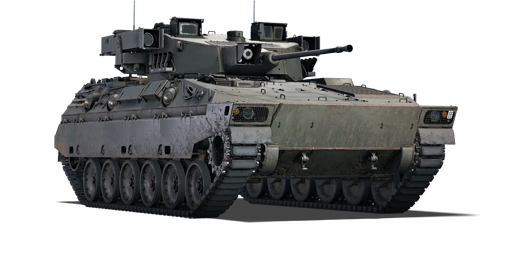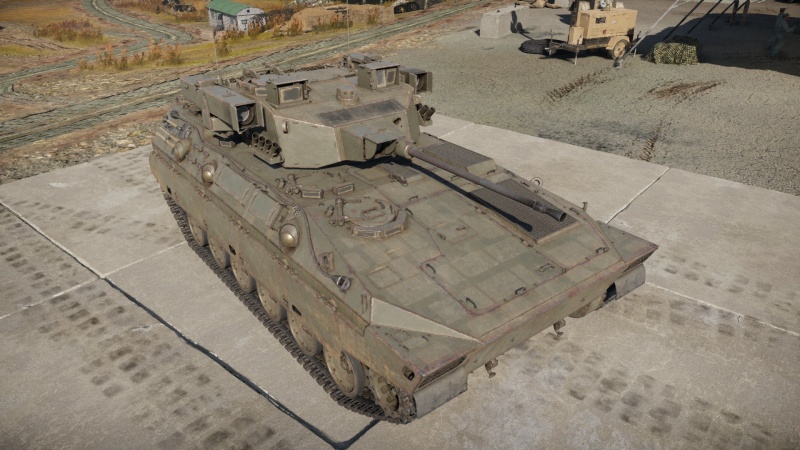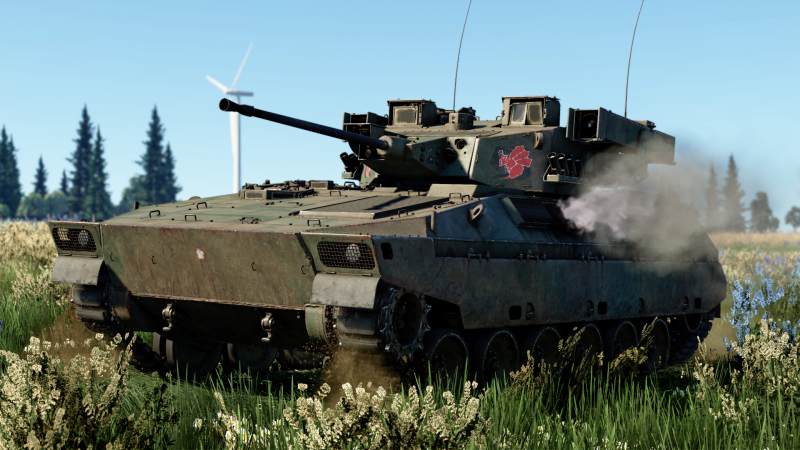Difference between revisions of "Type 89"
bangerland (talk | contribs) (I remind you, that the deleted text and pics rely on things this tank no longer has, there is no reason to not approve the page since wiki is about current tank state, even if it means that some sections have to simply unexist. here is some placeholder...) |
(Edits) |
||
| Line 20: | Line 20: | ||
<!-- ''Describe armour protection. Note the most well protected and key weak areas. Appreciate the layout of modules as well as the number and location of crew members. Is the level of armour protection sufficient, is the placement of modules helpful for survival in combat? If necessary use a visual template to indicate the most secure and weak zones of the armour.'' --> | <!-- ''Describe armour protection. Note the most well protected and key weak areas. Appreciate the layout of modules as well as the number and location of crew members. Is the level of armour protection sufficient, is the placement of modules helpful for survival in combat? If necessary use a visual template to indicate the most secure and weak zones of the armour.'' --> | ||
| − | While the Type 89's armour consists of | + | While the Type 89's armour consists of rolled homogenous armour, it is not any better than modern light tanks of other factions, which use double or even triple the amount of aluminium to give roughly the same amount of protection. This means that its sides and even angled turret will still be vulnerable to all autocannons and will trigger overpressure damage easily if hit in a weak spot, such as the back half of the tank. |
The armour profile can be closely compared to [[Merkava Mk.1 (USA)|Merkava Mk.1]], it has a long hull with turret on the back, and the entirety of it is sloped as much as possible. This means that inaccurate frontal hull shots will likely bounce and this tank should always face the opponent. Unfortunately, due to how big the turret is, the bounced shell might actually fly straight into it, and there aren't any special shields or additional armour for the turret crew on this tank. | The armour profile can be closely compared to [[Merkava Mk.1 (USA)|Merkava Mk.1]], it has a long hull with turret on the back, and the entirety of it is sloped as much as possible. This means that inaccurate frontal hull shots will likely bounce and this tank should always face the opponent. Unfortunately, due to how big the turret is, the bounced shell might actually fly straight into it, and there aren't any special shields or additional armour for the turret crew on this tank. | ||
| Line 75: | Line 75: | ||
The Type 89 is equipped with a 35 mm Oerlikon KDE autocannon, which is similar to the [[Oerlikon KDA (35 mm)|KDA]] variant used by the [[Gepard]], the [[Type 87]], and the [[Chieftain Marksman]], and is widely considered to be one of the most effective guns in regards to damage output and reliability. This is due to their moderate calibre and rate of fire: 35 mm is the largest of the small autocannons which allows it to have a much higher rate of fire than any 40 mm or 57 mm system. | The Type 89 is equipped with a 35 mm Oerlikon KDE autocannon, which is similar to the [[Oerlikon KDA (35 mm)|KDA]] variant used by the [[Gepard]], the [[Type 87]], and the [[Chieftain Marksman]], and is widely considered to be one of the most effective guns in regards to damage output and reliability. This is due to their moderate calibre and rate of fire: 35 mm is the largest of the small autocannons which allows it to have a much higher rate of fire than any 40 mm or 57 mm system. | ||
| − | The difference between them is that KDE cannon fires slower than KDA, but it uses tank-specific ammunition instead. This particular tank also has an autoloader magazine of 34 shells. Each shell is reloaded for about 5 seconds when not firing, unless you rearm on the capture point, which injects shells directly into | + | The difference between them is that KDE cannon fires slower than KDA, but it uses tank-specific ammunition instead. This particular tank also has an autoloader magazine of 34 shells. Each shell is reloaded for about 5 seconds when not firing, unless you rearm on the capture point, which injects shells directly into the autoloader every ~0.1 sec regardless of firing, which allows the gun to fire forever. |
It is very important to remember that even 3-5 direct APDS hits to a cannon barrel can neutralize almost any medium tank Type 89 can face, and should anything impenetrable suddenly attack, one can just destroy their gun to avoid being shot at. | It is very important to remember that even 3-5 direct APDS hits to a cannon barrel can neutralize almost any medium tank Type 89 can face, and should anything impenetrable suddenly attack, one can just destroy their gun to avoid being shot at. | ||
| − | Overall, autocannon allows the Type 89 to deal with most lightly armoured | + | Overall, the autocannon allows the Type 89 to deal with most lightly armoured vehicles in the game. The APDS ammunition allows it to deal with Main Battle Tanks from the side, though this should be carefully planned, as running out of autoloader ammo will almost definitely result in Type 89's demise. |
| − | + | The tank can use conventional HE to attack helicopters, if it must. Remember to use the laser rangefinder to target them quicker when it's researched. | |
Whenever you see that the main gun can't deal with an enemy target, or someone caught you off guard, consider using the ATGMs instead. | Whenever you see that the main gun can't deal with an enemy target, or someone caught you off guard, consider using the ATGMs instead. | ||
| Line 173: | Line 173: | ||
{{main|Type 79}} | {{main|Type 79}} | ||
| − | The Type 79 default ATGM has around 700 mm flat penetration at any range and has start velocity of 200 m/s, while retaining the high explosive mass of the [[Type 64 MAT]], making it one of the better ATGMs of the rank. This ATGM can deal with most tanks from the front, but be sure to avoid hitting modern NATO NERA composite armour, as these composite armours will minimise the damage done or even negate it entirely. When facing tanks with active ERA screens like [[M60A1 RISE (P)]], attack the screen with cannon first | + | The Type 79 default ATGM has around 700 mm flat penetration at any range and has start velocity of 200 m/s, while retaining the high explosive mass of the [[Type 64 MAT]], making it one of the better ATGMs of the rank. This ATGM can deal with most tanks from the front, but be sure to avoid hitting modern NATO NERA composite armour, as these composite armours will minimise the damage done or even negate it entirely. When facing tanks with active ERA screens like [[M60A1 RISE (P)]], attack the screen with the cannon first if possible, as such ERA plating may reduce the damage taken by the hostile tank and force you to use both missiles to take them down. |
| − | Two | + | Two missile launchers are located on the sides of the turret, with two reserve missiles being stored in the back of the hull (four total). Due to their placement, they only really arrive at crosshair location if the target is over 500 m away, so use them on targets which are away from the tank and practice aim in test drive to be able to use them at melee ranges, instead of relying on the targeting reticle. The second missile can be immediately fired after the first one, but firing it will cut off guidance for the first one, so '''only''' do this if you are sure it's on the correct course. Missile reload is only possible after '''both''' missiles are fired. |
| − | + | Type 79 ASM is a proximity HE modification of the Type 79 ATGM. When you aim above an enemy tank, it will automatically explode in 3 m range from the tank roof. Can be used to obliterate hostile ATGM carriers, but not very useful against medium tanks as they might get hit at the part with 20 mm roof thickness or missile might detonate too early and hit plates with 35+ mm thickness. | |
| − | |||
| − | Type 79 ASM is a proximity HE modification of | ||
{| class="wikitable" style="text-align:center" width="100%" | {| class="wikitable" style="text-align:center" width="100%" | ||
| Line 290: | Line 288: | ||
== Usage in battles == | == Usage in battles == | ||
<!-- ''Describe the tactics of playing in the vehicle, the features of using vehicles in the team and advice on tactics. Refrain from creating a "guide" - do not impose a single point of view but instead give the reader food for thought. Describe the most dangerous enemies and give recommendations on fighting them. If necessary, note the specifics of the game in different modes (AB, RB, SB).'' --> | <!-- ''Describe the tactics of playing in the vehicle, the features of using vehicles in the team and advice on tactics. Refrain from creating a "guide" - do not impose a single point of view but instead give the reader food for thought. Describe the most dangerous enemies and give recommendations on fighting them. If necessary, note the specifics of the game in different modes (AB, RB, SB).'' --> | ||
| − | |||
| − | While the tank has a lot of weapons, it is a bit on a slower side. Since it is not able to fire ATGMs on the move and its autoloader has a very limited ammo pool, Type 89 | + | While the tank has a lot of weapons, it is a bit on a slower side. Since it is not able to fire ATGMs on the move and its autoloader has a very limited ammo pool, the Type 89 has to rely on cover and area denial to move around and fight. |
| − | One way to avoid ammo starvation is to stand on a capture point, which will reload the gun for you, but capture points provide really poor cover and | + | One way to avoid ammo starvation is to stand on a capture point, which will reload the gun for you, but capture points provide really poor cover and must be captured first to provide ammo, which may not even happen. |
| − | If you clearly can't capture a point (there is a lot of tanks or snipers have it on | + | If you clearly can't capture a point (there is a lot of tanks or snipers have it on lockdown), work as a support or a flanker to avoid situations in which you are overwhelmed and can't retreat to reload. |
Despite having low ammo count, the main gun itself can deal a lot of damage to the crew or weapons if aimed properly, working as a decent deterrent for many tanks. It won't be able to beat [[Begleitpanzer 57]] or [[IT-1]] because it does not have APHE option and only does marginal damage to such tanks if they are careful, so use ATGM to destroy them if you can. | Despite having low ammo count, the main gun itself can deal a lot of damage to the crew or weapons if aimed properly, working as a decent deterrent for many tanks. It won't be able to beat [[Begleitpanzer 57]] or [[IT-1]] because it does not have APHE option and only does marginal damage to such tanks if they are careful, so use ATGM to destroy them if you can. | ||
| Line 308: | Line 305: | ||
* Type 79 ATGM is hard to dodge, have high penetration power of 700 mm and higher explosive mass than average ATGM | * Type 79 ATGM is hard to dodge, have high penetration power of 700 mm and higher explosive mass than average ATGM | ||
* Type 89 hull technically can survive some HEAT, HESH or even ATGM if they hit its engine compartment (left side), but it's not very reliable | * Type 89 hull technically can survive some HEAT, HESH or even ATGM if they hit its engine compartment (left side), but it's not very reliable | ||
| − | * | + | * Highly accurate stabilized main weapon |
* Can very efficiently exchange speed to manoeuvrability at gears 2 and 3 | * Can very efficiently exchange speed to manoeuvrability at gears 2 and 3 | ||
* Neutral steering | * Neutral steering | ||
| Line 319: | Line 316: | ||
* Low ammo count for the main gun autoloader and only 4 ATGM - will often get stuck for a long time hiding behind cover to reload | * Low ammo count for the main gun autoloader and only 4 ATGM - will often get stuck for a long time hiding behind cover to reload | ||
* Due to placement of ATGM launchers on turret, firing them in close combat is awkward and may result in a non-fatal hit | * Due to placement of ATGM launchers on turret, firing them in close combat is awkward and may result in a non-fatal hit | ||
| − | * Unlike [[Type 60 ATM]], ATGM only reloads after you fired both of loaded missiles | + | * Unlike [[Type 60 ATM]], ATGM only reloads after you fired both of loaded missiles |
| − | * ATGM | + | * ATGM launchers have zero gun depression, which can make close range encounters even more difficult |
* Very poor turn rate at gear 1 | * Very poor turn rate at gear 1 | ||
| Line 363: | Line 360: | ||
{{Japan light tanks}} | {{Japan light tanks}} | ||
| − | |||
[[Category:ATGM vehicles]] | [[Category:ATGM vehicles]] | ||
Revision as of 09:47, 10 September 2021
| This page is about the Japanese light tank Type 89. For equipment of the same adoption year, see Type 89 (Disambiguation). |
Contents
Description
The Type 89 is a rank VI Japanese light tank with a battle rating of 9.0 (AB/RB/SB). It was introduced in Update 1.85 "Supersonic".
The full name is known as the Mitsubishi Type 89 IFV (三菱89式装甲戦闘車), the Type 89 provides an autocannon weapon combined with an anti-tank guided missile for a diverse range of attack methods.
General info
Survivability and armour
While the Type 89's armour consists of rolled homogenous armour, it is not any better than modern light tanks of other factions, which use double or even triple the amount of aluminium to give roughly the same amount of protection. This means that its sides and even angled turret will still be vulnerable to all autocannons and will trigger overpressure damage easily if hit in a weak spot, such as the back half of the tank.
The armour profile can be closely compared to Merkava Mk.1, it has a long hull with turret on the back, and the entirety of it is sloped as much as possible. This means that inaccurate frontal hull shots will likely bounce and this tank should always face the opponent. Unfortunately, due to how big the turret is, the bounced shell might actually fly straight into it, and there aren't any special shields or additional armour for the turret crew on this tank.
Internal module placement is rather smart on paper, with the driver and MG operator hiding on the right side of the tank, and main weapon crew hiding at the back along with ammunition, while the rest of the tank is one giant engine compartment, sealed off with a 5 mm RHA screen, meaning that most hull shots should not be able to deal overpressure damage. In reality, the means of protecting the crew and critical weak points are insufficient. Most notably, the driver isn't completely sealed away from tank's front and the turret, meaning that any chemical shot coming to suspension from the right can overpressure the entire tank.
Due to overall low thickness of armour Type 89 can get overmatched. Whenever the tank hull side is even slightly opened, it will get easily penetrated by big guns, the armour is thick enough to trigger APHE fuses and even if it's a slow 19 mm fuse it will trigger off hitting the engine and RHA screen, then cause violent explosions next to ammo rack. Pure AP shells even of a small calibre autocannon will fly straight through the entire engine compartment, likely hitting the turret crew or ammo rack in the very back of the tank. It is also possible to lose the entire tank crew to a single coaxial autocannon spray from the right side, as nothing is protecting the driver there.
The one scenario in which the sealed compartment can truly work against kinetic shells is when the Type 89 is driving around the town, or hiding from snipers behind buildings, and someone suddenly shoots engine compartment into direction opposite from the crew, then enemy APHE may simply get stuck there, doing reduced damage to the turret crew. This does not make the situation any better though, as without team help or a very unlikely ATGM counterattack, Type 89 will still get repeatedly set on fire until it explodes.
Recommendations: Keep your opponents in front of you, if you can't - at least keep them on your left to reduce chances of an overpressure damage. Avoid being shot directly by 120+ mm shells. Do not needlessly taunt enemy SPAA. In close quarters you can be extremely aggressive and destroy enemy weapon or gunner as soon as possible. Otherwise try to scout enemies and hope to fire first or that there is a sniper to cover your back.
| Armour | Front (Slope angle) | Sides | Rear | Roof |
|---|---|---|---|---|
| Hull | 15 mm - 20 mm (81°) Upper Glacis 5 mm (81°) Ventilation 35 mm (26°-57°) Lower Glacis 20 mm (0°-50°) Sponson Front |
20 mm Upper 15 mm (Base) +10 mm (Sideskirts) Lower |
15 mm | 5 mm - 20 mm |
| Turret | 35 mm (11°-12°) Turret Front Sides 25 mm + 25 mm Gun mantlet |
20 mm | 15 mm (Base) + 5 mm (Storage Rack) | 10 mm |
| Cupola | 10 mm | |||
Notes:
- Fenders, Storage - 5 mm
- Turret Ring - 25 mm
- Tracks - 15 mm
- Suspension - 10 mm
- There are 10 mm or armour protection between the engine compartment and the crew compartment inside the vehicle
Mobility
| Game Mode | Max Speed (km/h) | Weight (tons) | Engine power (horsepower) | Power-to-weight ratio (hp/ton) | |||
|---|---|---|---|---|---|---|---|
| Forward | Reverse | Stock | Upgraded | Stock | Upgraded | ||
| Arcade | 78 | 48 | 26.5 | 930 | 1,145 | 35.09 | 43.21 |
| Realistic | 71 | 43 | 531 | 600 | 20.04 | 22.64 | |
On hard, flat terrain, the Type 89 will easily keep pace or out-speed many other vehicles due to it's reasonable power-to-weight ratio of 23 hp/t.
On soft, uneven or hilly terrain the Type 89 loses a lot of its speed advantage. This is due to the fact that the gearbox only provides 4 separate forward speeds. Due to the long gearing the Type 89 will often find itself unable to climb hills in gear 2 and will have to change to gear 1, which provides a top speed of just 9 km/h for hill-climbing. This means the Type 89 is often less mobile on hilly terrain than medium tanks. This problem can be mitigated to some extent by maintaining a good amount of speed (30+ km/h) and not stopping when travelling up hills.
As with Type 60 SPRG (C), reverse gear is much more responsive and will allow you to manoeuvre and retreat back around the corner during combat - use it if tank was forcibly stopped.
Modifications and economy
Armaments
Main armament
The Type 89 is equipped with a 35 mm Oerlikon KDE autocannon, which is similar to the KDA variant used by the Gepard, the Type 87, and the Chieftain Marksman, and is widely considered to be one of the most effective guns in regards to damage output and reliability. This is due to their moderate calibre and rate of fire: 35 mm is the largest of the small autocannons which allows it to have a much higher rate of fire than any 40 mm or 57 mm system.
The difference between them is that KDE cannon fires slower than KDA, but it uses tank-specific ammunition instead. This particular tank also has an autoloader magazine of 34 shells. Each shell is reloaded for about 5 seconds when not firing, unless you rearm on the capture point, which injects shells directly into the autoloader every ~0.1 sec regardless of firing, which allows the gun to fire forever.
It is very important to remember that even 3-5 direct APDS hits to a cannon barrel can neutralize almost any medium tank Type 89 can face, and should anything impenetrable suddenly attack, one can just destroy their gun to avoid being shot at.
Overall, the autocannon allows the Type 89 to deal with most lightly armoured vehicles in the game. The APDS ammunition allows it to deal with Main Battle Tanks from the side, though this should be carefully planned, as running out of autoloader ammo will almost definitely result in Type 89's demise.
The tank can use conventional HE to attack helicopters, if it must. Remember to use the laser rangefinder to target them quicker when it's researched.
Whenever you see that the main gun can't deal with an enemy target, or someone caught you off guard, consider using the ATGMs instead.
| 35 mm Oerlikon KDE | Turret rotation speed (°/s) | Reloading rate (seconds) | ||||||||||||
|---|---|---|---|---|---|---|---|---|---|---|---|---|---|---|
| Mode | Capacity | Fire rate | Vertical | Horizontal | Stabilizer | Stock | Upgraded | Full | Expert | Aced | Stock | Full | Expert | Aced |
| Arcade | 255 | 200 | -9°/+60° | ±180° | Two-plane | 57.1 | 79.1 | 96.0 | 106.2 | 112.9 | 0.39 | 0.35 | 0.32 | 0.30 |
| Realistic | 35.7 | 42.0 | 51.0 | 56.4 | 60.0 | |||||||||
Ammunition
| Penetration statistics | |||||||
|---|---|---|---|---|---|---|---|
| Ammunition | Type of warhead |
Penetration @ 0° Angle of Attack (mm) | |||||
| 10 m | 100 m | 500 m | 1,000 m | 1,500 m | 2,000 m | ||
| DM23 | APDS | 127 | 125 | 119 | 111 | 104 | 97 |
| DM11A1 | HE* | 5 | 5 | 5 | 5 | 5 | 5 |
| Shell details | |||||||||
|---|---|---|---|---|---|---|---|---|---|
| Ammunition | Type of warhead |
Velocity (m/s) |
Projectile Mass (kg) |
Fuse delay (m) |
Fuse sensitivity (mm) |
Explosive Mass (TNT equivalent) (g) |
Ricochet | ||
| 0% | 50% | 100% | |||||||
| DM23 | APDS | 1,400 | 0.38 | N/A | N/A | N/A | 75° | 78° | 80° |
| DM11A1 | HE* | 1,175 | 0.55 | 0 | 0.1 | 204 | 79° | 80° | 81° |
Ammo racks
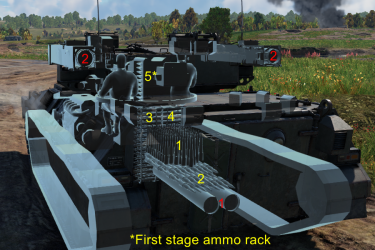
| Full ammo |
1st rack empty |
2nd rack empty |
3rd rack empty |
4th rack empty |
5th rack empty |
6th rack empty |
7th rack empty |
8th rack empty |
|---|---|---|---|---|---|---|---|---|
| 15 | 15 (+0) | 14 (+1) | 13 (+2) | 12 (+3) | 11 (+4) | 10 (+5) | 9 (+6) | 8 (+7) |
| 9th rack empty |
10th rack empty |
11th rack empty |
12th rack empty |
13th rack empty |
14th rack empty |
15th rack empty |
Visual discrepancy |
|
| 7 (+8) | 6 (+9) | 5 (+10) | 4 (+11) | 3 (+12) | 2 (+13) | 1 (+14) | No |
Additional armament
The Type 79 default ATGM has around 700 mm flat penetration at any range and has start velocity of 200 m/s, while retaining the high explosive mass of the Type 64 MAT, making it one of the better ATGMs of the rank. This ATGM can deal with most tanks from the front, but be sure to avoid hitting modern NATO NERA composite armour, as these composite armours will minimise the damage done or even negate it entirely. When facing tanks with active ERA screens like M60A1 RISE (P), attack the screen with the cannon first if possible, as such ERA plating may reduce the damage taken by the hostile tank and force you to use both missiles to take them down.
Two missile launchers are located on the sides of the turret, with two reserve missiles being stored in the back of the hull (four total). Due to their placement, they only really arrive at crosshair location if the target is over 500 m away, so use them on targets which are away from the tank and practice aim in test drive to be able to use them at melee ranges, instead of relying on the targeting reticle. The second missile can be immediately fired after the first one, but firing it will cut off guidance for the first one, so only do this if you are sure it's on the correct course. Missile reload is only possible after both missiles are fired.
Type 79 ASM is a proximity HE modification of the Type 79 ATGM. When you aim above an enemy tank, it will automatically explode in 3 m range from the tank roof. Can be used to obliterate hostile ATGM carriers, but not very useful against medium tanks as they might get hit at the part with 20 mm roof thickness or missile might detonate too early and hit plates with 35+ mm thickness.
| Type 79 missile | Reloading rate (seconds) | ||||||
|---|---|---|---|---|---|---|---|
| Capacity (Belt) | Vertical | Horizontal | Stabilizer | Stock | Full | Expert | Aced |
| 4 (2) | 0°/+12° | N/A | N/A | 13.00 | 11.50 | 10.60 | 10.00 |
Ammunition
| Penetration statistics | |||||||
|---|---|---|---|---|---|---|---|
| Ammunition | Type of warhead |
Penetration @ 0° Angle of Attack (mm) | |||||
| 10 m | 100 m | 500 m | 1,000 m | 1,500 m | 2,000 m | ||
| Type 79 | ATGM | 700 | 700 | 700 | 700 | 700 | 700 |
| Type 79 ASM | ATGM-HE | 35 | 35 | 35 | 35 | 35 | 35 |
| Shell details | ||||||||||
|---|---|---|---|---|---|---|---|---|---|---|
| Ammunition | Type of warhead |
Velocity (m/s) |
Range (m) |
Projectile Mass (kg) |
Fuse delay (m) |
Fuse sensitivity (mm) |
Explosive Mass (TNT equivalent) (g) |
Ricochet | ||
| 0% | 50% | 100% | ||||||||
| Type 79 | ATGM | 296 | 4,000 | 19.9 | 0.05 | 0.1 | 5,500 | 80° | 82° | 90° |
| Type 79 ASM | ATGM-HE | 296 | 4,000 | 19.9 | 0.05 | 0.1 | 3,010 | 79° | 80° | 81° |
Ammo racks
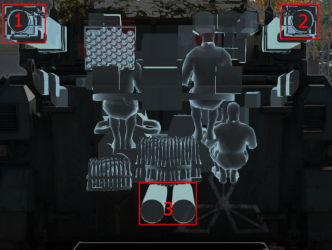
| Full ammo |
Visual discrepancy |
|---|---|
| 4 | No |
Notes:
- The left ATGM is fired first.
- The reload process will only begin when both ATGM have been fired off the Type 89's side launchers
Optics and night vision
The Type 89 receives night vision imagers once the tier 3 modification 'NVD' is researched. This unlocks standard 500 x 300 resolution thermal sights for the gunner, as well as standard image intensifiers for all crew (available in third person view in AB/RB additionally).
| Type 89 Optics | ||||||
|---|---|---|---|---|---|---|
| Type of optic | Magnification | Night Vision Devices | ||||
| Image Intensifier | Thermal Imager Resolution |
Notes | ||||
| Resolution | Light Mult | Noise Level | ||||
| Gunner's Sight | 2.0x - 8.0x | -- | -- | -- | 500 x 300 | Intensifier & thermal sights unlocked by 'NVD' modification (tier 3) |
| Commander's View | 6.0x | 1600 x 1200 | 9.0 | High | N/A | Intensifier unlocked by 'NVD' modification (tier 3) |
| Driver's View | 1.0x | 800 x 600 | 5.0 | High | N/A | Intensifier unlocked by 'NVD' modification (tier 3) |
Machine guns
Type 74 machine gun isn't doing anything special on this tank, as Type 89 can "scout" tanks directly without making any noise, but it can be sometimes used together with main gun when fighting other ATGM tanks or helicopters, as to add a chance of survival against ATGM by shooting them down mid-flight.
| 7.62 mm Type 74 | ||||
|---|---|---|---|---|
| Mount | Capacity (Belt) | Fire rate | Vertical | Horizontal |
| Coaxial | 1,000 (250) | 500 | N/A | N/A |
Usage in battles
While the tank has a lot of weapons, it is a bit on a slower side. Since it is not able to fire ATGMs on the move and its autoloader has a very limited ammo pool, the Type 89 has to rely on cover and area denial to move around and fight.
One way to avoid ammo starvation is to stand on a capture point, which will reload the gun for you, but capture points provide really poor cover and must be captured first to provide ammo, which may not even happen.
If you clearly can't capture a point (there is a lot of tanks or snipers have it on lockdown), work as a support or a flanker to avoid situations in which you are overwhelmed and can't retreat to reload.
Despite having low ammo count, the main gun itself can deal a lot of damage to the crew or weapons if aimed properly, working as a decent deterrent for many tanks. It won't be able to beat Begleitpanzer 57 or IT-1 because it does not have APHE option and only does marginal damage to such tanks if they are careful, so use ATGM to destroy them if you can.
Pros and cons
Pros:
- Has 2 ATGM loaded at the same time and can fire them in quick succession
- Type 79 ATGM is hard to dodge, have high penetration power of 700 mm and higher explosive mass than average ATGM
- Type 89 hull technically can survive some HEAT, HESH or even ATGM if they hit its engine compartment (left side), but it's not very reliable
- Highly accurate stabilized main weapon
- Can very efficiently exchange speed to manoeuvrability at gears 2 and 3
- Neutral steering
- Good reverse speed, turns better in reverse than forward
- Has thermal sight
Cons:
- Weak armour - It has worse protection from overpressure damage than TAM or Warrior with add-on composite shields and also can lose an entire crew to a single 23 mm API-T or even APDS shot from the right side
- Low ammo count for the main gun autoloader and only 4 ATGM - will often get stuck for a long time hiding behind cover to reload
- Due to placement of ATGM launchers on turret, firing them in close combat is awkward and may result in a non-fatal hit
- Unlike Type 60 ATM, ATGM only reloads after you fired both of loaded missiles
- ATGM launchers have zero gun depression, which can make close range encounters even more difficult
- Very poor turn rate at gear 1
History
At the beginning of the 1980s, the JSDF wanted to replace its outdated Type 60 and Type 73 APCs with more modern IFVs, similar to the American Bradley and the German Marder. The JSDF drew up a set of requirements and tasked the Mitsubishi company with developing a suitable replacement.
In 1984, funding was approved to build four different prototypes, all of which underwent testing until 1986. By 1989, one prototype design was selected and was adopted within the armed forces under the designation of Type 89.
Initially, the JSDF estimated the need for about 300 Type 89s to be built. However, the end of the Cold War in the 1990s combined with a limited budget prevented a rapid mass-production of Type 89 to take place. In fact, production was proceeding at a very low rate, with just over 50 vehicles entering service with the JSDF by 1999.
Although production of Type 89 was discontinued in 2004, the vehicle is still in service with the JSDF today. As of 2016, a total of 68 vehicles were present in the JSDF's inventory from the initially planned 300.
- From Devblog
Media
- Skins
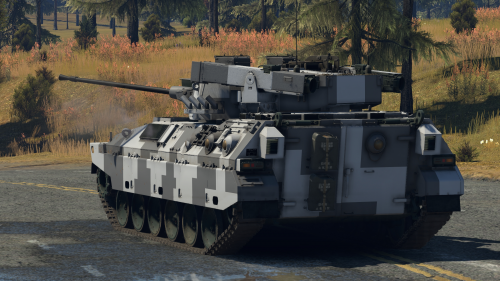
- Videos
See also
External links
| Japan light tanks | |
|---|---|
| Type 89 | I-Go Ko |
| Type 95 | Ha-Go · Ha-Go Commander |
| Type 98 | Ke-Ni |
| Other | Ka-Mi |
| IFV | Type 89 |
| RCV | Type 87 RCV (P) · Type 87 RCV · RCV (P) |
| MCV | Type 16 (P) · Type 16 (FPS) · Type 16 |
| USA | ▅M24 · ▅M41A1 |


